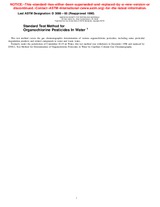We need your consent to use the individual data so that you can see information about your interests, among other things. Click "OK" to give your consent.
ASTM D3086-85
Test Method for Organochlorine Pesticides in Water (Withdrawn 1996)
STANDARD published on 1.1.1985
The information about the standard:
Designation standards: ASTM D3086-85
Note: WITHDRAWN
Publication date standards: 1.1.1985
SKU: NS-22460
The number of pages: 16
Approximate weight : 48 g (0.11 lbs)
Country: American technical standard
Category: Technical standards ASTM
Annotation of standard text ASTM D3086-85 :
Keywords:
Chlorinated hydrocarbon pesticides, Chromatography-gas (water), Pesticide content, Pesticides, Water-organic constituents, Water-pathogenic constituents, organochlorine pesticides content (of water), test, ICS Number Code 13.060.50 (Examination of water for chemical substances)
Additional information
| 1. Scope |
|
1.1 This test method covers the gas chromatographic determination of various organochlorine pesticides, including some pesticidal degradation products and related compounds in water and waste water. Such compounds are composed of carbon, hydrogen, and chlorine, but may also contain oxygen, sulfur, phosphorus, nitrogen, or other halogens. 1.2 The following compounds may be determined individually by this test method: aldrin, [alpha]-BHC, [beta]-BHC, [delta]-BHC, [gamma]-BHC(lindane), captan, [alpha]-chlordane, [gamma]-chlordane, chlordene, DDD, DDE, DDT, dichloran, dieldrin, endosulfan, endrin, HBH, HCP, heptachlor, heptachlor epoxide, isodrin, methoxychlor, mirex, and PCNB. Multicomponent mixtures, toxaphene, technical chlordane, and others may also be determined (Note 1). The fluorinated compound trifluralin may also be determined when using an electron-capture detector. This test method may be used for the determination of many other organochlorine pesticides. However, the analyst should demonstrate that it is in fact applicable to the specific compound or compounds of interest before applying it to sample analysis. Note 1-For chemical names of the pesticides see Appendix X1.1.3 The test method sensitivity limit ranges from 1 ng/L to 10 ng/L for single-component pesticides and 50 ng/L to 1000 ng/L for multicomponent pesticides when analyzing 1 L of drinking water or low-organic background surface water. 1.4 When organochlorine pesticides exist as complex mixtures, the individual compounds may be difficult to distinguish. High, low, or otherwise unreliable results may be obtained through misidentification or one compound obscuring another of lesser concentration, or both. Provisions incorporated in this method are intended to minimize the effects of such interferences. 1.5 This test method has been interlaboratory tested for natural waters (river, estuarine, lake). The analyst should recognize that bias precision reported in 15.1 and 16.1 may not apply to other waters. 1.6 The values stated in SI units are to be regarded as the standard. The values stated in inch-pound units are given in parentheses and are provided for information only. 1.7 This standard may involve hazardous materials, operations, and equipment. This standard does not purport to address all of the safety problems associated with its use. It is the responsibility of whoever uses this standard to consult and establish appropriate safety and health practices and determine the applicability of regulatory limitations prior to use. For specific precautionary statements, see 9.10. |
We recommend:
Technical standards updating
Do you want to make sure you use only the valid technical standards?
We can offer you a solution which will provide you a monthly overview concerning the updating of standards which you use.
Would you like to know more? Look at this page.




 Cookies
Cookies
